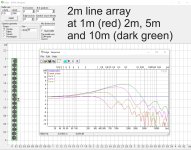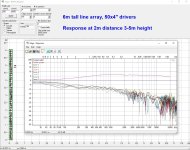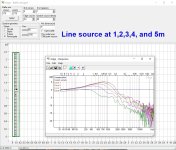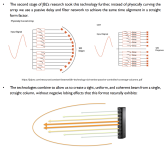did you also previously say you did arrays in the past ?Yep, DCX464. I go back and forth with it and the BMS4594he, on all my MEH builds.
if so how does an array compare to a Danley horn ?
did you also previously say you did arrays in the past ?
if so how does an array compare to a Danley horn ?
Yep. twenty-four of the commonly used 3.5" TC9's.
The lines are convertible between straight-standing and CBT. Comments apply to both versions.
I really like their mid-range, very smooth and detailed at the same time. And it's cool the way they mitigate floor and ceiling bounce.
The 3.5" drivers suffer when trying to handle lows and highs. Not enough displacement for lows. And too much center-to-center distance to function as a true line up high. I mean it makes sense...it is what it is.....can't really ask a small mid-range driver to handle wavelengths that stretch it's size matchups (in both directions).
I'd love to build 7-8ft tall lines that have a 3 lines. A line of ribbons/planars for HF/VHF, a line of bass/sub drivers for sub/low-mid, and a line of whatever sized mid-range ties it all together. 3 vertical lines...... tight-packed / interwoven horizontally, as optimal as possible.
The best "lines" I've heard have been full-range electrostats. Along with a few planars and ribbons. Their HF/VHF and mid-range, sound superb to me.
Low extension, and max SPL are of course their limitations... (limitations which led me to look towards prosound designs.)
The MEH horns are a great compromise for me. Damn close to the sound of my stats, and with low end, dynamics, and SPL out the gazoo.
just my mileage 🙂
Show us a line array that doesn't have vertical beaming, for reference.arrays don't have vertical beaming 😉
of course but thats not my direction. most will not be interested in tall lines. you may find however that non linear arrays have a phasey quality if there are spaces between tweetersarrays don't have vertical beaming 😉
Show us a line array that doesn't have vertical beaming, for reference.
Depends on how you define beaming I guess.
For me, I associate the term as describing a radiation pattern that narrows as frequency increases.
Or in other words, directivity index increases with frequency, like certain horn types are know to do.
Line arrays don't have that narrowing vs frequency property.
The line produces a supposed cylindrical wavefront.
At broadest overview, the length/height of the line controls how low in frequency the line will produce the cylindrical wavefront.
And the physical closeness of the driving elements control how high in frequency the wavefront is cylindrical.
Sound leaves the cylinder perpendicularly. It doesn't narrow by frequency.
At any listening height below the top of an electrostatic (which behaves as a line array vertically at least), the HF/VHF sounds the same...no rolloff.
Get a few mere inches above the top of the stat, and HF/VHF dramatically disappear. It's like a horizontal sound barrier for the HF/VHF, due to the perpendicular radiation. So not what I'd call beaming.
you may find however that non linear arrays have a phasey quality if there are spaces between tweeters
Yep, exactly.
When c2c spacing of the HF/VHF elements is too far apart for line theory to hold, the result is a bunch of separately timed arrivals.
Stay out of the wind Lol
I mean if we are in the near field we dont experience the effectsWhat do you mean of course.... its a lie
you explained it in post 66
Thanks for the learning. A picture says all the words, I was hoping to get some examples. "Line Array" is sorta vague in discussion , because we have to say which line array. They are not all created equal and I am sure they are pushing towards better performance as time moves on.Depends on how you define beaming I guess.
For me, I associate the term as describing a radiation pattern that narrows as frequency increases.
Or in other words, directivity index increases with frequency, like certain horn types are know to do.
Line arrays don't have that narrowing vs frequency property.
The line produces a supposed cylindrical wavefront.
At broadest overview, the length/height of the line controls how low in frequency the line will produce the cylindrical wavefront.
And the physical closeness of the driving elements control how high in frequency the wavefront is cylindrical.
Sound leaves the cylinder perpendicularly. It doesn't narrow by frequency.
At any listening height below the top of an electrostatic (which behaves as a line array vertically at least), the HF/VHF sounds the same...no rolloff.
Get a few mere inches above the top of the stat, and HF/VHF dramatically disappear. It's like a horizontal sound barrier for the HF/VHF, due to the perpendicular radiation. So not what I'd call beaming.
Is a huge blanket statement, and if used as all encompassing.... its inherently incorrect.arrays don't have vertical beaming 😉
@what is interesting is the Horizontal, which is likely due to an Array where there are two rows of drivers, thus the line isn't symmetrical. and neither is the polar, horizontally
Last edited:
It sure is. The J array is composed of parts which could be considered an array in their own right."Line Array" is sorta vague in discussion ,
Each an array in a different sense, for a different purpose.
Hi, It's just the graph that shows such extreme beaming, in reality as long as listener is "within" the line it's fine.
Make a thought experiment: Have noticed that on any public address event with a line array system I heard the top end, right? Probably all the audience did, although they are scattered all around the area. So, such system doesn't beam as the graph suggests, otherwise most audience would not have any top end.
Line array narrow coverage is due to varying path length from all sound sources in the array to an observation point. Assuming it's straight line array without any special DSP sauce: sounds from all transducers superimpose, so constructively interfere for long wavelengths and average out for short wavelengths. Observe outside the array and there is little sound on highs as it has averaged out.
What about observed within the array? assuming straight line array, sound that arrives first is with shortest path length, with simple trigonometry it's from a driver that is at same height as the observer. Sound from drivers adjacent to that come second and so on. Basically you have the beaming, but it's at any height within the array, the situation is same no matter witch height one observes within the array.
Make a thought experiment: Have noticed that on any public address event with a line array system I heard the top end, right? Probably all the audience did, although they are scattered all around the area. So, such system doesn't beam as the graph suggests, otherwise most audience would not have any top end.
Line array narrow coverage is due to varying path length from all sound sources in the array to an observation point. Assuming it's straight line array without any special DSP sauce: sounds from all transducers superimpose, so constructively interfere for long wavelengths and average out for short wavelengths. Observe outside the array and there is little sound on highs as it has averaged out.
What about observed within the array? assuming straight line array, sound that arrives first is with shortest path length, with simple trigonometry it's from a driver that is at same height as the observer. Sound from drivers adjacent to that come second and so on. Basically you have the beaming, but it's at any height within the array, the situation is same no matter witch height one observes within the array.
Last edited:
I'd love to build 7-8ft tall lines that have a 3 lines
blasphemy ! 5 way or bust !
but seriously here is my 5 way line array concept:
https://www.diyaudio.com/community/attachments/1740819463331-png.1429201/
4.5 + khz - Aurum Cantus G3
https://www.parts-express.com/Aurum...U9G9CQwlN8Zwa0M0iKVe1AxqbdajS2O9TM6JKvlL-WTcm
1.2 khz - 4.5 khz - Radian 8”
https://radianaudio.com/collections/ribbon/products/lm8k-wide-band-planar-ribbon-transducer
350 hz - 1.2 khz - 6NMB420
https://www.eighteensound.it/en/products/lf-driver/6-5/8/6NMB420
80 hz - 350 hz - Beyma 10NC700ND
https://www.beyma.com/speakers/Fich...rs-data-sheet-low-mid-frequency-10MC700Nd.pdf
-80 hz -21” NTLW5000 ( 1 per box, asymmetrical vent )
https://www.eighteensound.it/en/products/lf-driver/21-0/4/21ntlw5000-4
i hope you can critique this design which i describe in detail here:
slight reshuffling of components in the lower 3 frequency bands.
5" B&C 5NSM38 bucket is replaced with 18 Sound 6NMB420 midrange / midbass
https://www.eighteensound.it/en/products/lf-driver/6-5/8/6NMB420
i have developed a cooling solution that will be able to extract heat from the back chamber without needing a bucket midrange which can directly dissipate heat by having the chamber formed by the cast aluminum basket ... however based on hornresp "max spl" tool this heat exchanger i developed isn't really needed ... but i have that option as backup.
if anyone is interested my...
5" B&C 5NSM38 bucket is replaced with 18 Sound 6NMB420 midrange / midbass
https://www.eighteensound.it/en/products/lf-driver/6-5/8/6NMB420
i have developed a cooling solution that will be able to extract heat from the back chamber without needing a bucket midrange which can directly dissipate heat by having the chamber formed by the cast aluminum basket ... however based on hornresp "max spl" tool this heat exchanger i developed isn't really needed ... but i have that option as backup.
if anyone is interested my...
This thread is total mess, but line/array speaker theory and practise is a real challenge...
The Edge simple simulation for Windows https://www.tolvan.com/index.php?page=/edge/edge.php



so, a straight line array must have huge eq for highs, but still variation per distance is problematic
Curved/delay-shaded array helps!
Some references
https://audioartistry.com/papers_keele.htm
https://jblpro.com/resource/constan...eries-passive-controlled-coverage-columns.pdf
https://convexoptimization.com/TOOLS/meyer_line_array.pdf
https://static.martin-audio.com/downloads/ease/AdvancesinLineArray.pdf

The Edge simple simulation for Windows https://www.tolvan.com/index.php?page=/edge/edge.php



so, a straight line array must have huge eq for highs, but still variation per distance is problematic
Curved/delay-shaded array helps!
Some references
https://audioartistry.com/papers_keele.htm
https://jblpro.com/resource/constan...eries-passive-controlled-coverage-columns.pdf
https://convexoptimization.com/TOOLS/meyer_line_array.pdf
https://static.martin-audio.com/downloads/ease/AdvancesinLineArray.pdf

you may find however that non linear arrays have a phasey quality if there are spaces between tweeters
if i could build my own driver i would build a continuous line.
but such drivers died out for a reason - the market for them is too small to support mass production.
most people want a 3 inch long ribbon that is a drop in replacement for a 19 mm dome in a standard 3-way. the market for such small ribbons is large enough that you can stay in business selling them. such a ribbon can be stretched to a 5" long model without altering the overall design and built on the same production line. then it can be arrayed to any length.
both Fountek and Aurum Cantus seem to top out at 5" ribbon. apparently Fountek had a longer version but i can't find it for sale. likewise i remember B&G had long planars but again they went poof. it isn't enough to create a good driver - if the market isn't big enough nobody will carry it. i have that issue with even some prosound drivers from Italy where they are simply not sold in America. only the most popular models are.
building a 6 foot long ribbon would require a ground up design then maybe 10 people would buy it. it could make economic sense if you made it in your garage by yourself but it could never make sense as a business with a factory and employees.
i have accepted that i will never find a continuous line source like B&G used to offer. in the end everything is a compromise.
actually that is depressing.you may find however that non linear arrays have a phasey quality if there are spaces between tweeters.
i only thought of frequency response of the system until now and according to my mental models i could keep it close to flat even with gaps between drivers.
but now i realize there is also time domain and if we consider that every gap is actually a small reversed phase signal relative to ideal line source then some of these will arrive delayed so the error versus ideal response will not be minimum phase ...
my logic used to be there will always be more drivers in phase than out of phase so overall the signal will be preserved ... but i haven't considered that some of these out of phase signals might register not as dips in frequency response but as their own separate signals coming in later in time ...
and in fact the delay in time from them will be long compared to the time difference of arrival of sound to the two ears ... so it could definitely mess with imaging and sound a bit more like reverberant field than pin point imaging of a point source ...
if that is the case then Danely Horn guys will die laughing after listening to my "end game" system should it ever be built
depressing.
on a positive note though at least none of these errors will arrive BEFORE the main signal. the brain prioritizes first arrival and considers delayed arrivals as reflections. so maybe at least some imaging will be preserved. though it won't be as stark as with a Danley horn which is both a point source and minimizes wall reflections.
i guess it comes down to what you're looking for in a system. if you want the best imaging then maybe an array of separate ribbons with gaps between them isn't for you.
but remember in prosound ( which is where arrays come from ) there is no imaging AT ALL ! it's not even stereo ! and yet people still prefer live concerts to listening at home. which means that you can still enjoy music even without perfect imaging.
also when you consider how different imaging is with speakers vs headphones versus in a car and most people listen in headphones, in a car or live and rarely using two speakers set up with perfect angle - perhaps Danley guys like to talk about imaging not because it's so important but because it's what their system is good at.
that's the struggle - everybody claims that the one thing their system is good at is what is most important. the guy with an MTX Jackhammer and Titanium Bullet Supertweeters in a Honda civic and a guy with a 3" fullrange speaker driven by a tube headphone amp both think they have the best system.
that said i will never build a Danley Horn because there are enough of those in the world.
i have no interest in building something that isn't unique.
i agree that it's a pretty good design, but it's not MY design.
Last edited:
When c2c spacing of the HF/VHF elements is too far apart for line theory to hold, the result is a bunch of separately timed arrivals
i think it's different when stacking ribbons like this:
https://www.parts-express.com/Aurum...FVkzJZKquDHNUA9RJaFx-PSKveGmjDwRoCTHsQAvD_BwE
and full ranges like this:
https://www.parts-express.com/Peerl...05A1O2salZc6BWZsWnoIY_dYKu0iEycBoC7KgQAvD_BwE
because the full range will not radiate HF energy evenly - it will have LOBES in HF response
here is a normalized off axis response of a 6" cone ( Faital 6PR160 / data from Vance Dickason )
and here is a normalized vertical directivity of a 5" ribbon ( Fountek Neo CD 2.0 / data again form Vance Dickason )
here is the problem with the 6" cone:
the 4 khz purple contour is the last one that looks even. after that they go into random shapes.
from the normalized off axis charts it is also clear that problems start at 4.5 khz ... which for a 3.5" versus a 6.5" would probably start at 8.5 khz ...
by comparison the normalized vertical response of ribbon has nulls but no peaks.
so a line array of 3.5" full ranges may be closer to an array of point sources even when butted up against each other ... whereas a line array of ribbons may be closer to a line source with gaps ... in other words they won't behave the same ...
but yes there will still be issues ...
Stay out of the wind Lol
i don't get it - so now you're saying don't build arrays ?
didn't you just say you would love to build one again ?
line/array speaker theory and practise is a real challenge
i am trying to stay positive here and note that the response will average out in space. that is in a real room you aren't just listening to on-axis response but to reverberant field ... above 200 hz anyway and below that to standing waves
that said clearly i will need to learn that program and play with it
any other simulation programs could help me ?
VCAD2 can draw directivity spectrograms but is much more difficult to use than Edge
Boxsim is much easier
Specifically for LAs
Ulysses for pros https://www.ifbsoft.de/documents/e_diploma thesis_vh_simulation of line-arrays.pdf download sw
https://jblpro.com/en/softwares/vertec-line-array-calculator-v1-3-1-windows by JBL Pro
More papers of theory
https://pub.dega-akustik.de/DAGA_2024/files/upload/paper/198.pdf
https://www.cieri.net/Documenti/JBL/Documenti tecnici/JBL - Analysis of Loudspeaker Line Arrays.pdf
etc. use Google!
Boxsim is much easier
Specifically for LAs
Ulysses for pros https://www.ifbsoft.de/documents/e_diploma thesis_vh_simulation of line-arrays.pdf download sw
https://jblpro.com/en/softwares/vertec-line-array-calculator-v1-3-1-windows by JBL Pro
More papers of theory
https://pub.dega-akustik.de/DAGA_2024/files/upload/paper/198.pdf
https://www.cieri.net/Documenti/JBL/Documenti tecnici/JBL - Analysis of Loudspeaker Line Arrays.pdf
etc. use Google!
I agree. This thread is total mess.
Who brought line array into here?
About beaming...in domestic environment, we hear first arriving direct sound. Then room reflections later. If speaker has significantly different radiation pattern, like mismatch between directivity of bigger midbass already beaming at crossover, to wide dispersion of tweeter, quite typical, even on axis response may be flat, but of axis will not be uniform. Such speaker will spray the room with different response as main front signal. This mismatch of directionality will force brain to work harder to process the differences between first arriving signal and refletions. Listening fatigue follows. Flat on axis and smooth of axis is best aproach to designing multiway speakers.
Who brought line array into here?
About beaming...in domestic environment, we hear first arriving direct sound. Then room reflections later. If speaker has significantly different radiation pattern, like mismatch between directivity of bigger midbass already beaming at crossover, to wide dispersion of tweeter, quite typical, even on axis response may be flat, but of axis will not be uniform. Such speaker will spray the room with different response as main front signal. This mismatch of directionality will force brain to work harder to process the differences between first arriving signal and refletions. Listening fatigue follows. Flat on axis and smooth of axis is best aproach to designing multiway speakers.
- Home
- Loudspeakers
- Multi-Way
- 3 way speakers